|

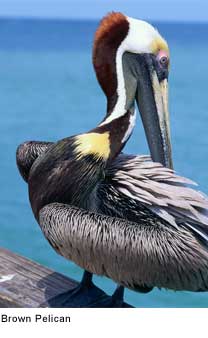 Who Needs Variety? The seven species of pelican are generally similar in shape, and except for one species, have white plumage. Their most famous feature is their elongated bills and massive throat pouches. The bill can grow to be 40-50 cm long, and is usually larger in males than females. Who Needs Variety? The seven species of pelican are generally similar in shape, and except for one species, have white plumage. Their most famous feature is their elongated bills and massive throat pouches. The bill can grow to be 40-50 cm long, and is usually larger in males than females.
for example:
Spot-billed Pelican: This is a small pelican, at 125-150 cm length. It is mainly white, with a grey crest, hind neck and tail. In breeding plumage, there is a pink tone to the rump and under wings. Non-breeders are off-white in these areas, and immature birds are more extensively brown. As the species' name implies, there are grey spots on the pink bill in the breeding season.

Two Ways of Feeding:
1.
Group fishing is a technique used by white pelicans all over the world. They will form a line to chase schools 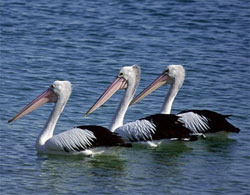 of small fish into shallow water, and then simply scoop them up. Large fish are caught with the bill-tip, then tossed up in the air to be caught and slid into the gullet head first. of small fish into shallow water, and then simply scoop them up. Large fish are caught with the bill-tip, then tossed up in the air to be caught and slid into the gullet head first.
2. Plunge-diving, used almost exclusively by the American
Brown Pelican, but only rarely by white pelicans like the Peruvian Pelican of the western South American coast, or the Australian Pelican.
Ancient Species Almost Everywhere: From the fossil record, it is known that pelicans have been around for over 40 million years. Modern pelicans are found on all continents except Antarctica: they are birds of inland and coastal waters and are absent from polar regions, the deep ocean, oceanic islands, and inland South America.
Nesting Season: Pelicans are gregarious and nest colonially, the male bringing the material, the female heaping it up to form a simple structure. Pairs are monogamous for a single season but the pair bond extends only to the nesting area; away from the nest mates are independent.

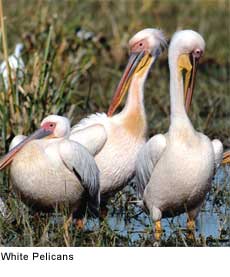 American White Pelican: The American White Pelican (Pelecanus erythrorhynchos) is a very large (50"–70") white bird with black wing tips and an enormous orange bill. They have a wing span of approximately 3 m . They are graceful in flight, moving their wings in slow powerful strokes. American White Pelican: The American White Pelican (Pelecanus erythrorhynchos) is a very large (50"–70") white bird with black wing tips and an enormous orange bill. They have a wing span of approximately 3 m . They are graceful in flight, moving their wings in slow powerful strokes.
Socialist Bird: Unlike the Brown Pelican, the American White Pelican does not dive for its food. Instead it practices cooperative fishing. Each bird eats more than 4 pounds of fish a
day, mostly carp, chubs, shiners, yellow perch, catfish, and jackfish.
Nest and Nestlings: White Pelicans nest in colonies of several hundred pairs on islands in remote brackish and freshwater lakes of inland North America. The most northerly nesting colony can be found on 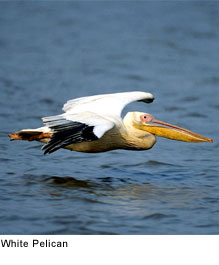 islands in the rapids of the Slave River between Fort Fitzgerald, Alberta and Fort Smith, Northwest Territories. The female lays 2 or 3 eggs in a shallow depression on the ground. Both parents incubate.They winter in central California and along the Pacific coast of Guatemala; also along the shores of the Gulf of Mexico. islands in the rapids of the Slave River between Fort Fitzgerald, Alberta and Fort Smith, Northwest Territories. The female lays 2 or 3 eggs in a shallow depression on the ground. Both parents incubate.They winter in central California and along the Pacific coast of Guatemala; also along the shores of the Gulf of Mexico.
Pelicans in Danger: Shooting by poachers is the largest known cause of mortality. Colonies are sensitive to disturbance and visits by humans can cause the pelicans to leave and abandon their nests. This species is protected by the Migratory Bird Treaty of 1972.

Pelican Symbolism:
Self-sacrificing: In medieval Europe, the pelican was thought to be particularly attentive to her young, to the point of providing her own blood when no other food was available. As a result, the pelican became a symbol of the Passion of Jesus and of the Eucharist. It also became a symbol in bestiaries for self-sacrifice, and was used in heraldry ("a pelican in her piety" or "a pelican vulning (wounding) herself"). Another version of this is that the Pelican used to kill its young and then resurrect them with its blood, this being analogous to the sacrifice of Jesus.
This legend may have arisen because the pelican used to suffer from a disease that left a red mark on its chest. Alternatively it may be that pelicans look as if they are doing that as they often press their bill into their chest to fully empty their pouch.
State Symbol: The symbol is used today on the Louisiana state flag and Louisiana state seal, as the Brown pelican is the Louisiana state bird.
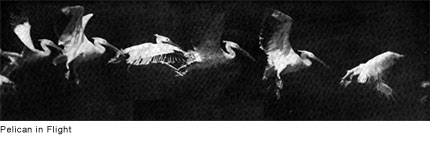
Pelican Species:
Pelecanus occidentalis, Brown Pelican
Pelecanus thagus, Peruvian Pelican
Pelecanus erythrorhynchos, American White Pelican
Pelecanus onocrotalus, Great White Pelican
Pelecanus crispus, Dalmatian Pelican
Pelecanus rufescens, Pink-backed Pelican
Pelecanus philippensis, Spot-billed Pelican
Pelecanus conspicillatus, Australian Pelican
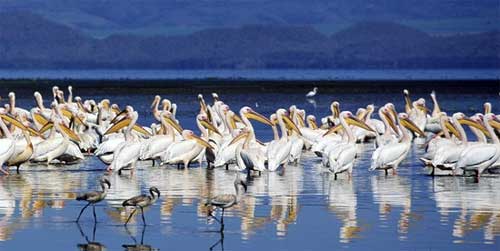
All text is available under the terms
of the GNU Free Documentation License
|